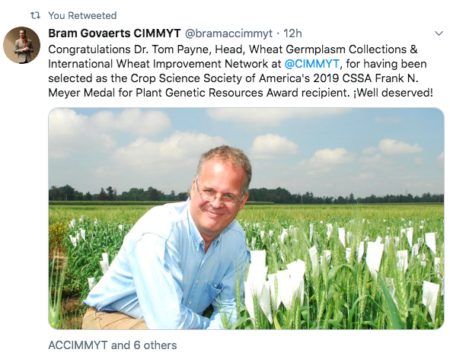So I’ve trawled the latest IPBES Global Assessment Summary for Policymakers for references to agricultural diversity, so you don’t have to.
Here’s the most relevant of the Key Messages:
A6. Globally, local varieties and breeds of domesticated plants and animals are disappearing. This loss of diversity, including genetic diversity, poses a serious risk to global food security by undermining the resilience of many agricultural systems to threats such as pests, pathogens and climate change. Fewer and fewer varieties and breeds of plants and animals are being cultivated, raised, traded and maintained around the world, despite many local efforts, which include those by indigenous peoples and local communities. By 2016, 559 of the 6,190 domesticated breeds of mammals used for food and agriculture (over 9 per cent) had become extinct and at least 1,000 more are threatened. In addition, many crop wild relatives that are important for long-term food security lack effective protection, and the conservation status of wild relatives of domesticated mammals and birds is worsening. Reductions in the diversity of cultivated crops, crop wild relatives and domesticated breeds mean that agroecosystems are less resilient against future climate change, pests and pathogens.
This is the assessment of what’s causing all this erosion, and why it’s important.
7. The number of local varieties and breeds of domesticated plants and animals and their wild relatives has been reduced sharply as a result of land use change, knowledge loss, market preferences and large-scale trade (well established) {2.2.5.2.6, 2.2.5.3.1}. Domestic varieties of plants and animals are the result of nature and human managed selection, sometimes over centuries or millennia, and tend to show a high degree of adaptation (genotypic and phenotypic) to local conditions (well established) {2.2.4.4}. As a result, the pool of genetic variation which underpins food security has declined (well established) {2.2.5.2.6}. 10 per cent of domesticated breeds of mammals were recorded as extinct, as well as some 3.5 per cent of domesticated breeds of birds (well established) {2.2.5.2.6} Many hotspots of agrobiodiversity and crop wild relatives are also under threat or not formally protected. The conservation status of wild relatives of domesticated livestock has also deteriorated. These wild relatives represent critical reservoirs of genes and traits that may provide resilience against future climate change, pests and pathogens and may improve current heavily depleted gene pools of many crops and domestic animals {2.2.3.4.3}. The lands of indigenous peoples and local communities, including farmers, pastoralists and herders, are often important areas for in situ conservation of the remaining varieties and breeds (well established) {2.2.5.3.1}. Available data suggest that genetic diversity within wild species globally has been declining by about 1 per cent per decade since the mid-19th century; and genetic diversity within wild mammals and amphibians tends to be lower in areas where human influence is greater (established but incomplete) {2.2.5.2.6}.
And finally, here are the relevant possible actions and pathways to achieve transformative change towards producing and consuming food sustainably (I’ve fixed some obvious typos):
- Promoting sustainable agricultural practices, such as good agricultural practices, agroecology, among others, multifunctional landscape planning and cross-sectoral integrated management {6.3.2}
- Conserving sustainably genetic resources for agriculture including diversity of genes, varieties, cultivars, breeds, landraces and species (e.g. SO, IPLC, CG) {6.3.2.1} (A6)
- Promoting the use of biodiversity-friendly management practices in crop and livestock production, forestry, fisheries and aquaculture, including, where relevant, traditional management practices associated with Indigenous Peoples and Local communities {6.3.2.1} (D6)
- Promoting areas of natural or semi-natural habitat within and around production systems, including those that are intensively managed – where necessary, restoring or reconnecting damaged or fragmented habitats. {6.3.2.1} (D6)
- Improving food market transparency (e.g traceability of biodiversity impacts, transparency in supply chains) through tools such as labelling and sustainability certification
- Improving equity in food distribution and the localization of food systems, where appropriate and where beneficial to Nature/NCP
- Reducing food wastes from production to consumption
- Promoting sustainable and healthy diets {6.3.2.1} (D6)
Key actors: (IG=Intergovernmental organizations; G=Governments; NGOs =Non-governmental Organizations; CG=Citizen, community groups, IPLC = Indigenous peoples and local communities; D=Donor agencies; SO= Science and educational organizations; P=Private sector)
There’s obviously much more that’s relevant to agrobiodiversity, for example on pollinators and soil microorganisms, but these are the bits that are specifically about crop and livestock diversity, as far as I can see. They haven’t received much attention in the press, alas.
